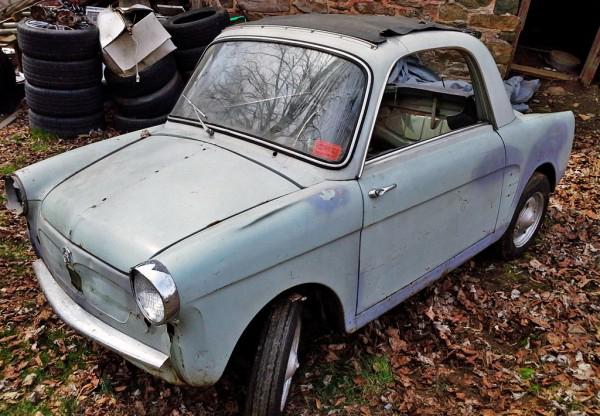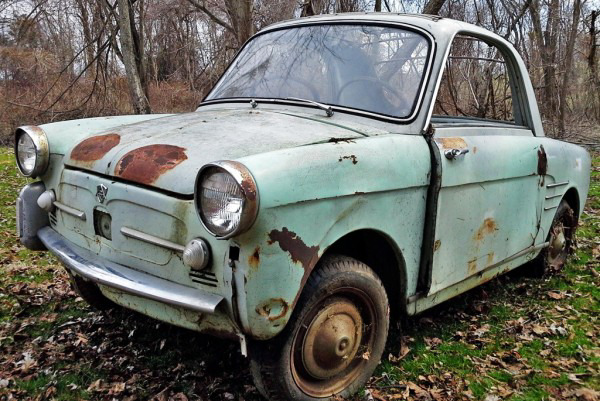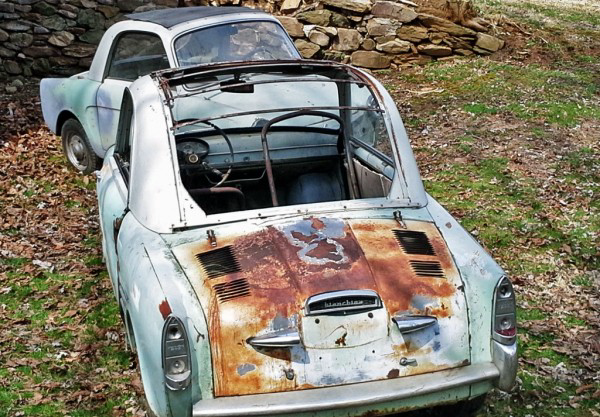Two of a Kind: 1961 Autobianchi Bianchina
Things here at BarnFinds have been going well lately. We have a lot of awesome plans in the works, we get to meet new enthusiasts every day, and best of all we get to do what we love! Yet, after writing countless emails every day, we can get a bit overwhelmed. Thankfully, the cure to our daily grind is getting to hunt for great finds! So when we spotted this pair of 1961 Autobianchi Bianchina, they brought a smile to our faces that only a Fiat based micro car can. Check out this pair here on eBay and hopefully they can get you through the grind too!
These Autobianchis aren’t in the best shape, but the seller claims both cars run. While both cars could be restored, one is missing its title and would likely be better suited as a parts car than a project. That being said, these little cars were essentially rebranded Fiat 500s, so finding parts shouldn’t be all that difficult. The Bianchina specific trim pieces will likely be the most hard to find parts, but there appears to be enough pieces to complete one of these. While they look rough, remember there really isn’t much to restore when the car is only 6 feet long.
The Autobianchi brand was born out of a collaboration between Bianchi (the bicycle company), Pirelli, and Fiat. The company primarily built micro cars, but ventured into the small family car market on several occasions. Eventually Bianchi sold their share of the company to Fiat and Pirelli, essentially giving Fiat free reign to use the brand as a test bed for their new ideas and products until they closed up shop in 1995.
While these projects might not be for you, there is no denying that they are cute. Every time we look at them, we can’t help but do it with a big grin on our faces. We hope the seller is realistic in their pricing, but we won’t know until the reserve comes off. Micro cars are going up in value, so if these can be had for the right price, we don’t see any reason one couldn’t come out ahead on them! With any luck they brought a smile to your face and helped you get through the day.
Auctions Ending Soon
 1971 Ford Mustang Mach 1Bid Now1 days$7,100
1971 Ford Mustang Mach 1Bid Now1 days$7,100
 2003 Porsche Boxster SBid Now1 days$5,500
2003 Porsche Boxster SBid Now1 days$5,500
 1966 Lincoln ContinentalBid Now1 days$500
1966 Lincoln ContinentalBid Now1 days$500
 2000 Jaguar XJ8LBid Now5 days$1,250
2000 Jaguar XJ8LBid Now5 days$1,250
 1977 Datsun 280ZBid Now6 days$275
1977 Datsun 280ZBid Now6 days$275





Comments
I want to see the expression of the faces of the employees at Auto Zone when you ask for a carb kit for one of these!!!
The downside:
– tiny
– slow, but the speed strakes just behind the door add a good 10 MPH
– 18-wheelers
The upside:
– great mileage
– full sunroofs
– park them anywhere
– parked, but they still run
Bottom line: A way to get into a real production microcar, cheap.
Looks like the one in the foreground in the last picture had an engine fire. That could sure be an issue.
I have owned five of these fun little cars. They are a blast to drive. I almost bought one new in 1961.
I would get these but no money to spend on them and no place to put them.
Each time I see cars like this, I think, who would have purchased them? Gas was what? .15 a gallon?…….You wonder what dealer sold them, who bought them………why
Dang they sure are cute, but I like small cars. Would love to see a fanatic restore.
Actually, a lot of people would have bought them-in Europe. You have to remember that this sort of car came about in the post war period, when resources in Europe were scarce and taxes were high. In some countries, things like gasoline were rationed and so a car that just got you there, cheaply, and made the most of a scarce commodity was a wonderful thing to own. Many cities were razed to the ground with carpet bombing and few industrial plants escaped unscathed. It took over twenty years for many countries to rebuild. You also have to consider the Suez crisis of 1956 and the effect it had on oil supplies for nations like the UK. All of a sudden oil was in short supply and many cars couldn’t be run because of fuel efficiency.
The final thing to consider is Italy itself. Much of the country has extremely narrow streets in small villages that date to centuries before the invention of the automobile. In those places, a tiny car is the only practical car since even something the size of the new Fiat 500 can be difficult to maneuver.
As for the US market, they were pretty much a flop here. Many small cars of the period were sold as a second car for the wife to drive so that the man would commute in the real car (it was a far less “progressive” time!) As such, this would have been just a small shopping car or maybe a city car and might have filled a similar niche to something like a Smart Fortwo does today.
The Bianchina was positioned as a sort of upmarket Fiat.
The 500 was in some senses the same as a Falcon sedan, basic second car transport and the Bianchina was the Mustang or Comet, depending on which variation you chose. If you wanted to spend even more there was a number of carrozzerie who had limited number special bodied cars based on Fiats of all sizes. There were even the larger ones but the post-war economy over there was tight which makes the 500-600 engine sort of the everyman size. Then you had the Abarths for performance minded types…
Utterley desirable, nice way to end the weekend. Thanks Josh.
Fridayarvoitis. I meant nice way to start the weekend…
This actually doesn’t look like a difficult project. The rocker is simple and could probably be fabricated with a sheet metal brake while the floor could either be done from flat sheet or possibly a reproduction pan for a 500 would work (I have no idea of this is true. It’s just a guess based on a shared platform.) The good car I would thus restore to it’s original condition and then sell it on to someone who wants one in that condition.
Now, the parts car is far more interesting to me. It has extensive rust, the engine has issues and it will have given it’s good parts to make the other one whole. However, it still retains it’s interesting shape and size and that is what I would want it for. I would end up quadrupling the horsepower by the time it’s done by using a donor drivetrain from an unusual source- a Smart car! The Smart uses a version of the engine in the Mitsubishi i kei car (sold as the iMEV electric car in the US) with more displacement than the original’s roughly 660cc. It’s also a compact powertrain designed to lay flat under the rear floor and so it would likely fit in the Autobianchi just fine. I would also try to adapt the front suspension, brakes and wheels from the Smart as well. I imagine the parts may need a mild narrowing, but seeing as both cars are fairly narrow to begin with it may be easier than it sounds. Otherwise, I would try to find original trim parts for the body, restore the interior back to close to stock and paint the shell some pastel color that would have been available on it when new. In the end, it would be a very serviceable modern car underneath with a charming classic shell on top. The only real negative to the whole idea would be that the Smart has one of the worst transmissions on sale today. It’s a semi-auto that is very unresponsive to inputs and shifts roughly. There are very few drivetrains that will fit this package though so unless I went with one off a 2 wheel drive quad bike, I can’t think of anything else that would work.
I agree about restomodding one of these. I actually want to do that when I find the right baby. I’m always paranoid about making sure the lensware is available, particularly when it follows the body contours like the rear ones do here. If they were specially made for these cars, the chances of finding a fresh set might not be good. Things would be bit easier if they were taken from the parts bin of a more widely produced model. Owner doesn’t say whether he has them but says trim items are available.
Jim-Bob, could keep things in the family by putting in modern 500 motorvation. What do you know about the twin air?
I like the Twin Air engine, but I just don’t think it would lie flat enough to work. I may be wrong, as I have not seen one in person yet, but I think it is too tall because the hood line of the 500 is tall and the twin air is basically half a 500’s 4 cylinder engine. I actually parked next to one with my Geo Metro the other day so that I could compare dimensions and noted just how much higher the hood is. Plus, then you would need to engineer some new suspension parts whereas with the Smart you would basically transfer the entire subframe or structure for a rear engine setup (the 500 is front engine/front drive and shares it’s mechanicals with the Panda and Punto).
Now, the tail lights are something I have been thinking about lately too. Instead of having to find originals, why not have them 3D printed? The CAD work isn’t that difficult to do for a relatively simple shape like this and is something a hobbyist could conceivably do using open source software (meaning free) like Autodesk. ( http://www.123dapp.com/ ) Once you have the design work done, you can send it off to companies who will run your program and make the lenses out of the materials you specify-so you don’t even have to own the printer. (I haven’t tried this yet, but it sounds like a good idea!) To go along with the modernization underneath, you could forgo the fresnel lens like lines inside and just make LED panels to illuminate things. This would save on limited electrical resources and give a small hint (to those who know to look) that things are not as they appear.
As far as it goes, I haven’t yet tried 3D printing, so I am not speaking from experience. However, I am planning to try to build a Reprap 3D printer over the summer so I have been doing a lot of research before I jump in with my wallet. I figure I can make one for around $300-$400 and it should be able to make objects that have a maximum size of a 6 inch cube. There are bigger printers out there, but I want to make my first one a conventional size that is well understood and documented. These can print in a variety of materials (supposedly someone made one that prints steel using a MIG welder!) but most commonly use either PLA or ABS plastic. For a car I would use ABS as PLA is a biodegradable plastic and might not hold up in a wet environment. Oh, also, most 3D printers make rather rough looking objects that require further refinement to look good. From what I have seen, people just mist the objects with acetone and that both strengthens them and smooths them out.
Been thinking the same thing about 3D printing and LEDs. A couple of issues, as you mentioned the stabitilty of the materials and the other probably bigger problem is getting them through the red tape of lensware here in oz. They would be concerned about how it would perform in a crash as well as light dispersal. Cheers Jim-Bob.
Ouch. I live in Florida, so I don’t have to worry about any sort of government vehicle inspections. Thus, passing “tech” never even crossed my mind. That being said, I think that it could work as it is not like the resultant lighting would be less visible than the originals. If anything, it would be a much safer system. Then again, you would probably want to check with the local authorities before going through the time and expense to do so.
As far as strength goes, I think that depends on the materials used and the printer that prints it. Some of the lower end consumer printers don’t do a good job of making a structurally sound item (especially if the item was not designed with the limitations of the printer in mind), but I think it would be possible to find a commercial one that could make a good one. I imagine there is a big difference between a $300 home printer built by a tinkerer and a $20,000 model used for commercial production of small runs of products. At that point it is all about finding a good company to print your designs ( I would do a few sets, not just the ones I needed. You can always sell the extras.)
These are very rare in Europe
In the Uk in the 60s we hardly ever saw one in the works.
Engines are available in Italy (the apprentices could fit one in about 15 minutes)
I’d restore both of them.
One has to remember that they are no wider than a motorbike and sidecar. Great driving one up on left hand bends but tend to fall over on right hands unless you seriously lean across!.
I finished a restoration on a 1959 500 early this year. Tons of stuff is available for the engine and running gear from mrfiat.com. Like was mentioned, the lenses and trim that are specific to the Bianchina will be the hardest part. The 500 was a fun little car to drive. I wouldn’t dare have it out on anything more than a 40 mph road, but it’s a fun little neighborhood zip around. The engine (identical to these) was easy to work on and tune, and there are some hop ups for it bigger cylinders, ported head, etc. You can easily work it up to 35 hp or so. Stock on the 499 cc is 17 hp.
I’m mainly bummed that they are so far away, or I’d be tempted to grab it. The floors are reproduced, and the other parts are easily fabbed. Hope someone gets them and gets one of them going out of the two. Great fun
As of this writing, bidding up to $4100.00. Too rich for my blood for a project car, but at least (hopefully) the bidder really wants it!